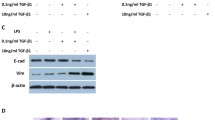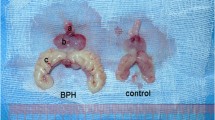Abstract
Purpose
To examine phosphodiesterase type 5 (PDE5) expression in the anterior fibromuscular stroma (AFMS) of the prostate. Although PDE5 expression was identified in the human prostate, differences in PDE5 expression in intra-prostatic regions are unknown. The AFMS in the prostate has peculiar innervations that could contribute to voiding function. Here, we examined regional differences in PDE5 expression in the prostate with special reference to the AFMS.
Methods
A total 18 human prostate and bladder specimens were obtained. Tissue specimens were processed by hematoxylin–eosin (H&E) staining and immunohistochemistry for PDE5. Immunoreactivity with PDE5 was evaluated using computer-assisted image analysis in the following regions: the AFMS, bladder neck, stromal hyperplasia in the transition zone, glandular hyperplasia in the transition zone (TZ gland), and the peripheral zone (PZ). The correlation between PDE5 expression in the AFMS and clinical data was analysed.
Results
Image analysis revealed that the median ratio of the PDE5-immunoreactive area to smooth muscle area by H&E staining was 74.7% in the AFMS. There was significantly higher PDE5 expression in the AFMS than in the TZ gland (p = 0.034) and PZ (p = 0.002). PDE5 expression in the AFMS was not significantly correlated with age, prostate volume, transition zone volume, or transition zone index. However, older men had a tendency to have higher PDE5 expression in the AFMS.
Conclusions
We found higher PDE5 expression in the AFMS compared with other prostatic regions, which suggested that the AFMS is a target region of PDE5 inhibitors in the prostate.
Similar content being viewed by others
References
Gacci M, Eardley I, Giuliano F, Hatzichristou D, Kaplan SA, Maggi M, McVary KT, Mirone V, Porst H, Roehrborn CG (2011) Critical analysis of the relationship between sexual dysfunctions and lower urinary tract symptoms due to benign prostatic hyperplasia. Eur Urol 60(4):809–825
Lue TF, Giuliano F, Montorsi F, Rosen RC, Andersson KE, Althof S, Christ G, Hatzichristou D, Hirsh M, Kimoto M, Lewis R, Mckenna K, MacMahon C, Morales A, Mulcahy J, Padma-Nathan H, Pryor J, de Tejada IS, Shabsigh R, Wagner G (2004) Summary of the recommendations on sexual dysfunctions in men. J Sex Med 1(1):6–23
McVary KT, Monnig W, Camps JL Jr, Young JM, Tseng LJ, van den Ende G (2007) Sildenafil citrate improves erectile function and urinary symptoms in men with erectile dysfunction and lower urinary tract symptoms associated with benign prostatic hyperplasia: a randomized, double-blind trial. J Urol 177(3):1071–1077
Stacey P, Rulten S, Dapling A, Phillips SC (1998) Molecular cloning and expression of human cGMP-binding cGMP-specific phosphodiesterase (PDE5). Biochem Biophys Res Commun 247(2):249–254
Morelli A, Filippi S, Mancina R, Luconi M, Vignozzi L, Marini M, Orlando C, Vannneli GB, Aversa A, Natali A, Forti G, Giogi M, Jannini EA, Ledda F, Maggi M (2004) Androgens regulate phosphodiesterase type 5 expression and functional activity in corpora cavernosa. Endocrinology 145(5):2253–2263
Ückert S, Kuthe A, Jonas U, Stief CG (2001) Characterization and functional relevance of cyclic nucleotide phosphodiesterase isoenzymes of the human prostate. J Urol 166(6):2484–2490
Filippi S, Morelli A, Sandner P et al (2007) Characterization and functional role of androgen-dependent PDE5 activity in the bladder. Endocrinology 148:1019–1029
Ückert S, Oelke M, Stief CG et al (2006) Immunohistochemical distribution of cAMP- and cGMP-phosphodiesterase (PDE) isoenzymes in the human prostate. Eur Urol 49:740–745
Zenzmaier C, Sampson N, Pernkopf D, Plas E, Untergasser G, Berger P (2010) Attenuated proliferation and trans-differentiation of prostatic stromal cells indicate suitability of phosphodiesterase type 5 inhibitors for prevention and treatment of benign prostatic hyperplasia. Endocrinology 151(8):3975–3984
McNeal JE (1972) The prostate and prostatic urethra: a morphologic synthesis. J Urol 107(6):1008–1016
McNeal JE (1978) Origin and evolution of benign prostatic enlargement. Investig Urol 15:340–345
Iwata T, Ukimura O, Inaba M, Kojima M, Kumamoto K, Ozawa H, Kawata M, Miki T (2001) Immunohistochemical studies on the distribution of nerve fibers in the human prostate with special reference to the anterior fibromuscular stroma. Prostate 48(4):242–247
Ukimura O, Iwata T, Ushijima S, Suzuki K, Honjo H, Okihara K, Mizutani Y, Kawauchi A, Miki T (2004) Possible contribution of prostatic anterior fibromuscular stroma to age-related urinary disturbance in reference to pressure-flow study. Ultrasound Med Biol 30(5):575–581
Ehrlich Y, Foster RS, Bihrle R, Cheng L, Tong Y, Koch MO (2010) Division of prostatic anterior fibromuscular stroma reduces urethral resistance in an ex vivo human prostate model. Urology 76(2):511 e10–3
Nishio K, Soh S, Syukuya T, Sato R, Sadaoka Y, Iwahata T, Suzuki K, Ashizawa Y, Kobori Y, Okada H (2014) Role of male pelvic floor muscles and anterior fibromuscular stroma in males on alpha(1)-blocker treatment: a magnetic resonance imaging study. Int J Urol 21(7):724–727
Kotera J, Fujishige K, Omori K (2000) Immunohistochemical Localization of cGMP-binding cGMP-specific phosphodiesterase (PDE5) in rat tissues. J Histochem Cytochem 48(5):685–693
Kaplan SA, Te AE, Pressler LB, Olsson CA (1995) Transition zone index as a method of assessing benign prostatic hyperplasia: correlation with symptoms, urine flow and detrusor pressure. J. Urol 154:1764–1769
Zhang W, Zang N, Jiang Y, Chen P, Wang X, Zhang X (2015) Upregulation of phosphodiesterase type 5 in the hyperplastic prostate. Sci Rep 5:17888
Zhao C, Kim SH, Lee SW et al (2011) Activity of phosphodiesterase type 5 inhibitors in patients with lower urinary tract symptoms due to benign prostatic hyperplasia. BJU Int 107:1943–1947
Ückert S, Waldkirch ES, Merseburger AS et al (2013) Phosphodiesterase type 5 (PDE5) is co-localized with key proteins of the nitric oxide/cyclic GMP signaling in the human prostate. World J Urol 31:609–614
Giuliano F, Ückert S, Maggi M et al (2013) The mechanism of action of phosphodiesterase type 5 (PDE5) inhibitors in the treatment of lower urinary tract symptoms related to benign prostatic hyperplasia. Eur Urol 63:506–516
Fibbi B, Morelli A, Vignozzi L et al (2010) Characterization of phosphodiesterase type 5 expression and functional activity in the human male lower urinary tract. J Sex Med 7(1):59–69
Gacci M, Corona G, Vignozzi L, Salvi M, Serni S, De Nunzio C, Tubaro A, Oelke M, Carini M, Maggi M (2015) Metabolic syndrome and benign prostatic enlargement: a systematic review and meta-analysis. BJU Int 115(1):24–31
Vignozzi L, Gacci M, Cellai I, Morelli A, Maneschi E, Comeglio P, Santi R, Filippi S, Sebastianelli A, Nesi G, Serni S, Carini M, Maggi M (2013) PDE5 inhibitors blunt inflammation in human BPH: a potential mechanism of action for PDE5 inhibitors in LUTS. Prostate 73(13):1391–1402
Morelli A, Comeglio P, Filippi S, Sarchielli E, Vignozzi L, Maneschi E, Cellai I, Gacci M, Lenzi A, Vannelli GB, Maggi M (2013) Mechanism of action of phosphodiesterase type 5 inhibition in metabolic syndrome-associated prostate alterations: an experimental study in the rabbit. Prostate 73(4):428–441
Iwata T, Ukimura O, Kojima M, Ozawa H, Kawata M, Miki T (1999) Age-related increase of the connective tissue in the anterior fibromuscular stroma of the prostate. Neurourol Urodyn 18(4):360
Funding
This research was funded by GlaxoSmithKline (GSK) Japan Research Grant 2016 (No. D14)
Author information
Authors and Affiliations
Corresponding author
Additional information
Publisher's Note
Springer Nature remains neutral with regard to jurisdictional claims in published maps and institutional affiliations.
Rights and permissions
About this article
Cite this article
Iwata, T., Fujihara, A., Shiraishi, T. et al. Higher expression of phosphodiesterase type 5 in the anterior fibromuscular stroma of the human prostate. World J Urol 38, 2915–2921 (2020). https://doi.org/10.1007/s00345-020-03095-1
Received:
Accepted:
Published:
Issue Date:
DOI: https://doi.org/10.1007/s00345-020-03095-1







